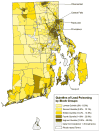The important health impact of where a child lives: neighborhood characteristics and the burden of lead poisoning
- PMID: 20972613
- PMCID: PMC3734857
- DOI: 10.1007/s10995-010-0692-6
The important health impact of where a child lives: neighborhood characteristics and the burden of lead poisoning
Abstract
Toxins and other health threats can cause health problems, whether they are present in the child's own home, other neighborhood homes where the child spends time, or common areas such as playgrounds. We assess the impact of where a child lives on the burden of lead poisoning. Statewide lead screening data was obtained from the Rhode Island Department of Health. Block group level indicators of old housing and poverty were obtained from the US Census. Of the 204,746 study children, 35,416 (17.3%) had a blood lead level≥10 μg/dL. The proportion of study children who were lead poisoned in each block group ranged from 0.0 to 48.6%. The proportion of study children with an elevated blood lead level increased from 8% among children living in block groups in the lowest quintile of poverty to 31% for those in the highest quintile for poverty. Old housing also had an important impact on the risk of lead poisoning. The proportion of children with an elevated blood lead level increased from 7% among children living in block groups in the lowest quintile for pre-1950 housing to 27% for those in the highest quintile for pre-1950 housing. The adjusted odds ratio was 1.64 for the highest quintile of poverty and 1.77 for the highest quintile of pre-1950 housing. The findings of this large, statewide study demonstrate the powerful impact of where children live on the risk of lead poisoning. The findings have important implications for understanding the problem of lead poisoning and for planning primary prevention programs.
Figures
References
-
- American Academy of Pediatrics, Committee on Environmental Health. Screening for elevated blood lead levels. Pediatrics. 1998;101:1072–1078. - PubMed
-
- Baghurst PA, McMichael AJ, Wigg NR, Vimpani GV, Robertson EF, Roberts RJ, et al. Environmental exposure to lead and children’s intelligence at the age of seven years: The Port Pirie Cohort Study. New England Journal of Medicine. 1992;327(18):1279–1284. - PubMed
-
- Bellinger DC, Stiles KM, Needleman HL. Low-level lead exposure, intelligence and academic achievement: A long-term follow-up study. Pediatrics. 1992;90:855–861. - PubMed
Publication types
MeSH terms
Grants and funding
LinkOut - more resources
Full Text Sources
Medical





